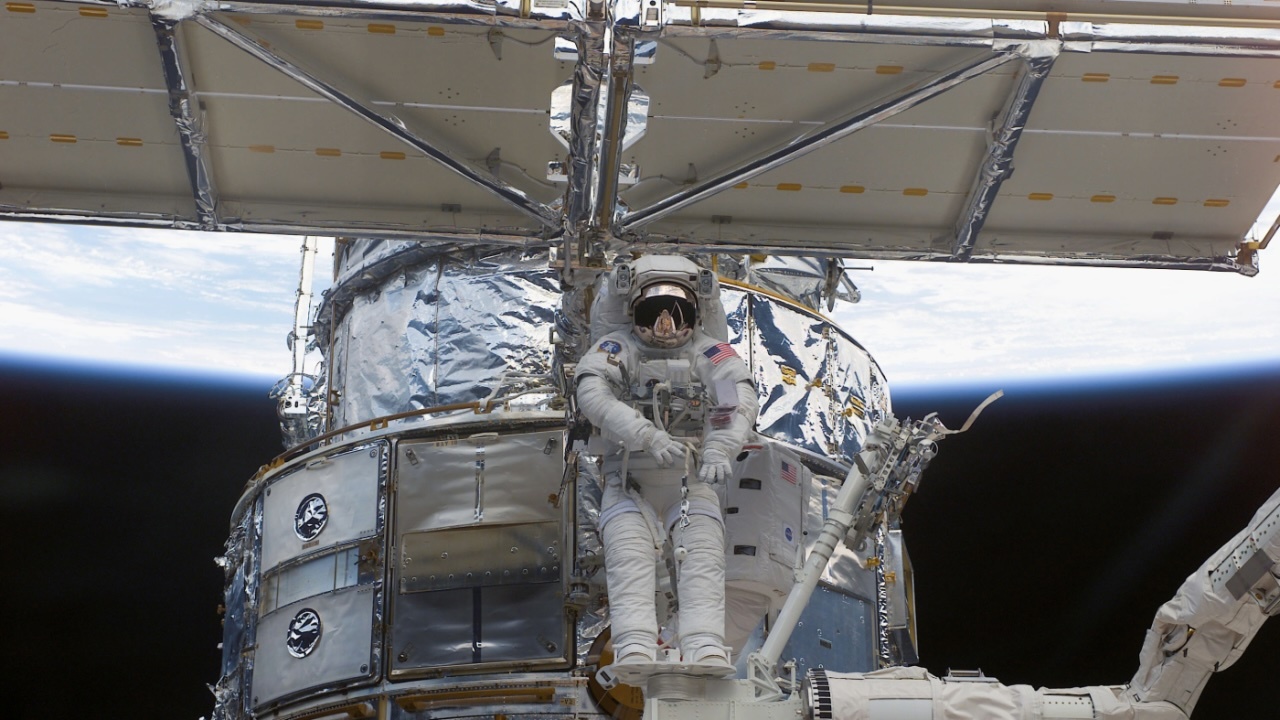13.12.2023
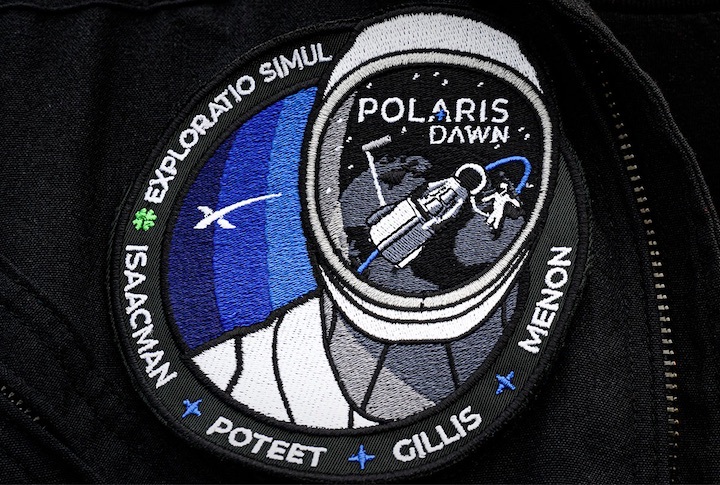
SpaceX private Polaris Dawn space mission delayed to April 2024
"Schedule slips should be expected."
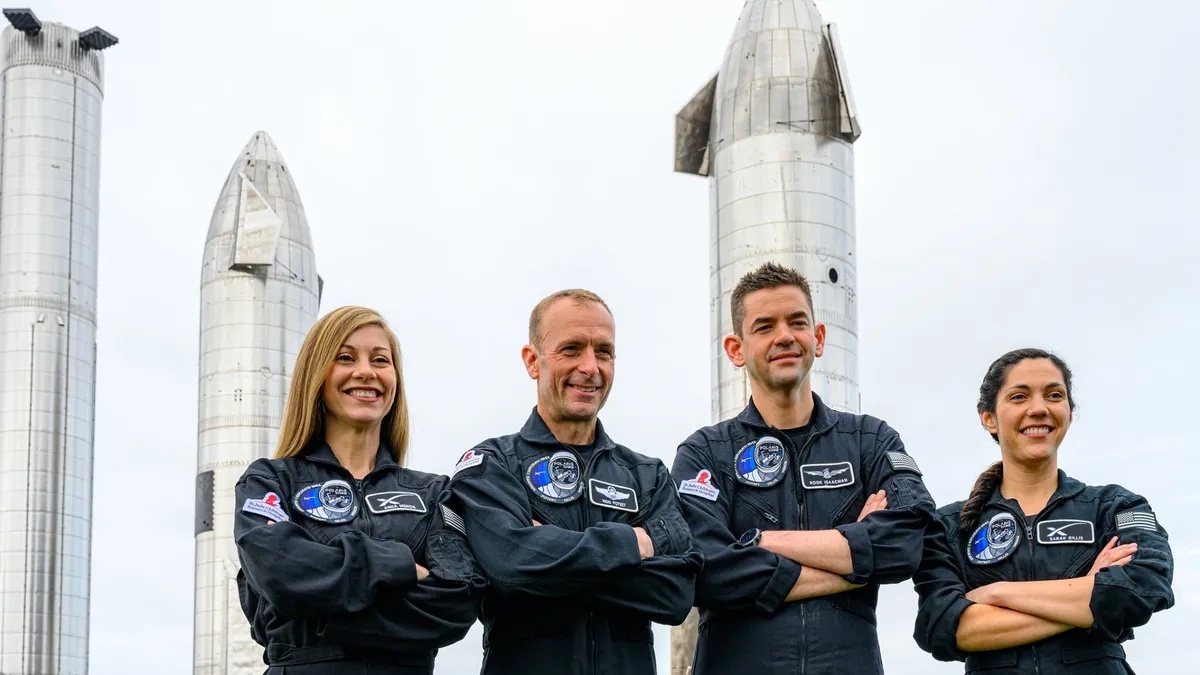
Polaris Dawn crewmembers Anna Menon, Scott Pottet, Jared Isaacman and Sarah Gillis in front of SpaceX Starship spacecraft versions. (Image credit: Polaris Program / John Kraus)
A SpaceX mission featuring the first private spacewalk is delayed once again, this time to April 2024. It's known as Polaris Dawn.
Jared Isaacman, the billionaire funding the private space mission in collaboration with SpaceX, disclosed the news Saturday (Dec. 9) in replies on X (formerly Twitter) to a question about when his mission will run.
"April is the goal to launch & the pace of training is accelerating," Isaacman wrote, adding in another tweet, "It's a development program with ambitious objectives. Schedule slips should be expected."
The mission timeline has now been pushed back approximately 18 months from the initial launch target of the fourth quarter of 2022, set when Isaacman first announced the program in February 2022.
Polaris Dawn is the gate-opener mission of the Isaacman-funded Polaris Program, which aims to conduct three private missions using SpaceX spacecraft. Isaacman was also the commander of Inspiration4, a 2021 space excursion that sent four civilian astronauts (including Isaacman) to orbit aboard a SpaceX craft and raised money for St. Jude Children's Research Hospital in Memphis.
Polaris Dawn aims to attempt the first-ever commercial spacewalk, test Starlink in space and do science work. Astronauts include Isaacman as commander, pilot Scott Poteet (a retired U.S. Air Force colonel), and senior SpaceX ground controllers Sarah Gillis and Anna Menon. Like Inspiration4, Polaris Dawn will also raise money for St. Jude.
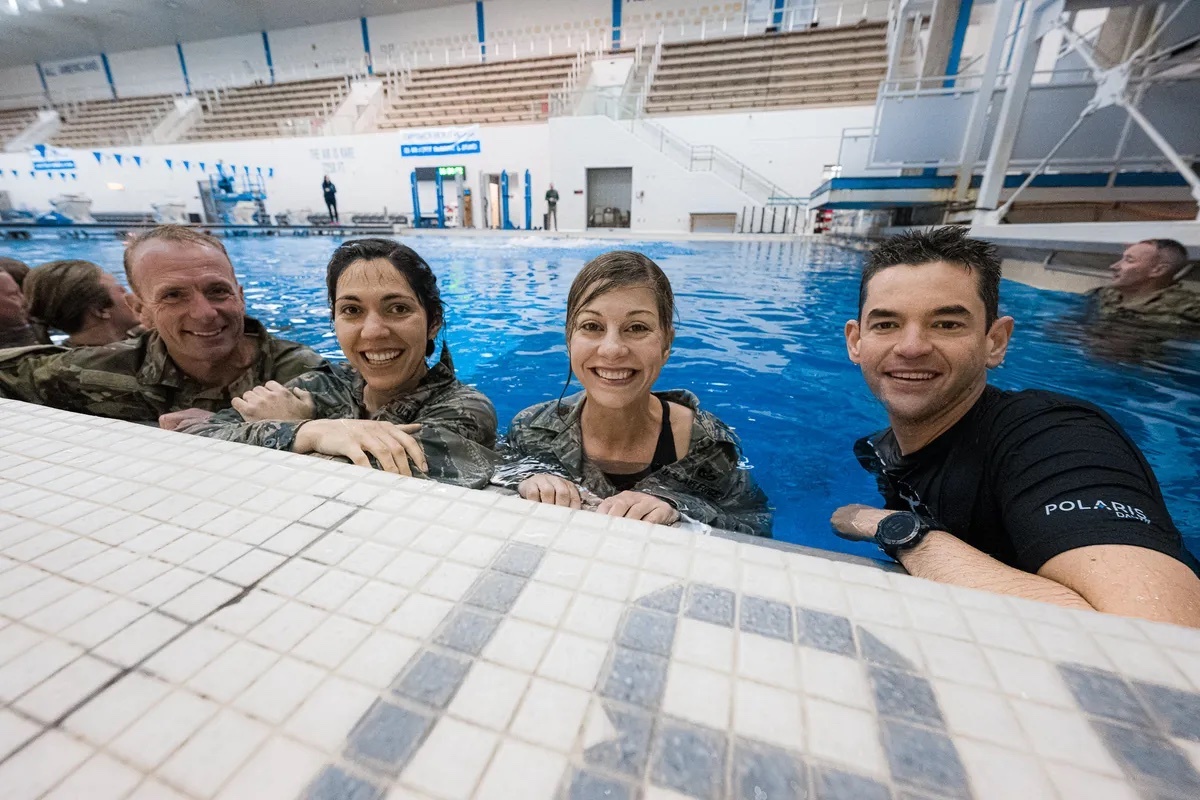
The Polaris Dawn crew smiles for the camera during diving training at U.S. Air Force Academy. From left: Scott Pottet, Sarah Gallis, Anna Menon and Jared Isaacman. (Image credit: Polaris Program/John Kraus)
In another X post, Isaacman outlined some challenges that are in store for the Polaris Dawn team in developing the mission. For instance, it will require new spacesuits optimized for spacewalks that are different from the intravehicular sleek spacesuits SpaceX typically uses for astronaut missions.
"That includes suit changes for mobility, life support redundancy, sun glare, some resiliency to MMOD (micrometeorites and orbital debris)," Isaacman wrote, adding that Crew Dragon also needs to be designed to let out air and then let it back in again: "The vehicle was (initially) designed to go to vacuum only in an emergency," he said.
The laser experiment is facing unspecified challenges: "It's not just turning the router switch to the ON position (as) every Draco (thruster) firing could break a link," Isaacman said.
There are also concerns about the radiation exposure the crew would face as they attempt to break an altitude record in low Earth orbit: "Avionics don't like radiation which means there is a lot to analyze and sim to get right."
Isaacman emphasized he has confidence in the team in fixing these issues: "SpaceX engineers are doing an outstanding job tackling big problems very quickly."
The larger Polaris Program is still in the early stages of planning, but Isaacman has said he wants to use Starship for at least one of the missions. He also has offered to boost the orbit of the Hubble Space Telescope; NASA has opened solicitations to the community to see about the feasibility of other offers.
Starship itself is facing technical challenges that will likely see some of its bigger contracts delay as well, as the system has made two space attempts in 2023. The spacecraft soared high in the air on both occasions, but never achieved its goal of circling the Earth and splashing down again.
NASA's first human moon landing with Starship, Artemis 3, will likely now take place no earlier than 2027, according to a recent report with the Government Accountability Office. The agency has been warning for months that the moon landing will likely delay from 2025 while Starship continues testing, but it is prepared to pivot to other types of missions for the moonbound Artemis program. A round-the-moon mission known as Artemis 2 will launch with four astronauts onboard in late 2024, using NASA's Orion spacecraft.
Quelle: SC
----
Update: 11.02.2024
.
SpaceX's private Polaris Dawn orbital mission delayed to summer 2024
Launch had been targeted for April.
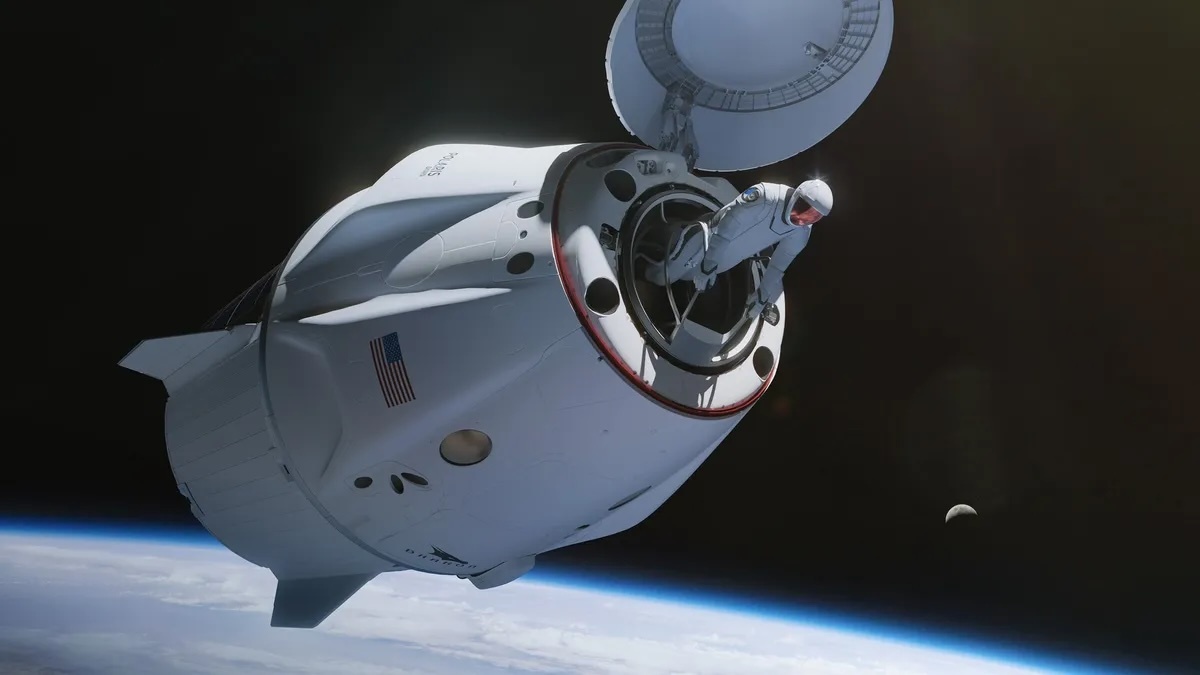
Illustration of a Polaris Dawn crewmember conducting the first-ever private spacewalk. (Image credit: Polaris Program via X)
We'll have to wait a few more months to see the first-ever private spacewalk.
Launch of the private Polaris Dawn mission — which aims to notch that milestone, as well as test SpaceX's Starlink internet service in space and conduct a variety of science experiments — has been delayed from April to no earlier than this summer, its organizers announced on Thursday (Feb. 8).
"The additional time continues to provide necessary developmental time to ensure both the completion of these mission goals and a safe launch and return of Dragon and the crew," the Polaris Program said via X on Thursday.
As that post indicates, Polaris Dawn will use SpaceX hardware, launching four people to Earth orbit in a Crew Dragon capsule atop a Falcon 9 rocket.
Those four are Jared Isaacman, the billionaire behind the Polaris Program of private space exploration, retired U.S. Air Force colonel Scott Poteet, and SpaceX employees Sarah Gillis and Anna Menon.
Isaacman will command Polaris Dawn. Poteet will serve as pilot, and Gillis and Menon will be the payload specialist and medical officer, respectively.
Polaris Dawn will spend up to five days in Earth orbit. Like September 2021's Inspiration4 mission, which Isaacman also commanded and funded, Polaris Dawn will be a free flyer; it will not meet up with the International Space Station. The coming mission will also raise money for St. Jude Children's Research Hospital in Memphis, as Inspiration4 did.
The latest delay is not the first for Polaris Dawn; it initially was targeted to launch in late 2022.
Polaris Dawn will be the first of three missions in the Polaris Program, which Isaacman wants to help push the boundaries of private spaceflight.
The billionaire entrepreneur has said that he plans to use SpaceX's next-generation Starship rocket for at least one of the Polaris missions. Starship has conducted two test flights to date, in April and November of last year. SpaceX is currently gearing up for Starship's third flight, which could lift off as soon as this month.
Quelle: SC
----
Update: 16.04.2024
.
Polaris Dawn is getting closer and closer to being launch ready
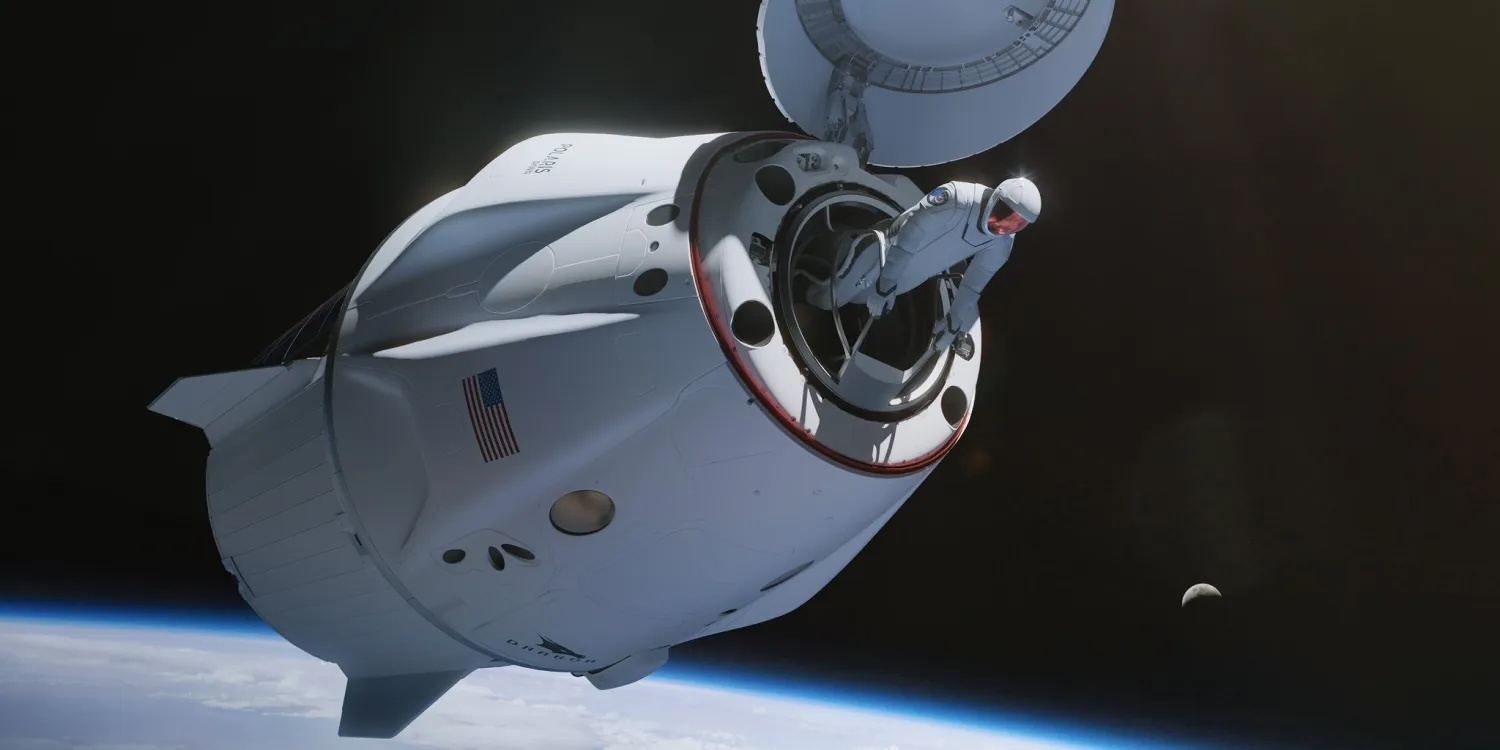
Things are slowly falling into place for the Polaris Program‘s first mission, Polaris Dawn. The mission is nearing milestones that might finally give it a launch date that will actually hold.
Polaris Dawn Dragon and spacesuit finishing testing
Polaris Dawn, a private mission being paid for by Shift4 CEO Jared Issacman, who also paid for and flew on Inspiration4 in 2021. The goal of the mission is to fly higher than any human spaceflight since Apollo, perform the first private spacewalk, and conduct numerous science experiments in orbit.
Like Inspiration4, Polaris is partnering with SpaceX to complete this. Currently, SpaceX is the only company capable of this sort of feat. To do so, the company has modified its Dragon spacecraft to support spacewalk operations and develop an upgraded spacesuit to be used in the vacuum of space.
That spacecraft was sent to vacuum chamber testing earlier this month. Teams will recreate expected conditions in space by lowering and raising the vehicle’s pressures to ensure Dragon performs as expected both during and after the first commercial spacewalk,” SpaceX stated on social media.
This will be able to close out the vast majority of concerns with bringing a vacuum into the Dragon’s main cabin, although no test is as good as doing it in the real world. Polaris Dawn is set to launch in early summer, so just like the early NASA astronauts that took part in the Gemini Program, the crew of Polaris Dawn will be pushing what Dragon was designed to do.
The crew will be safe from being inside a vacuum while in Dragon as they will be wearing an upgraded suit that according to Issacman, finished development in March. While the current flight suit used by SpaceX Dragon passengers would work for keeping them safe in a vacuum, it is not designed to be used outside the spacecraft. Really, it wouldn’t be much use outside of one of the Dragon’s four seats as the hose used to connect it to the life-support systems doesn’t look to be that long.
SpaceNews reported in February that the new spacesuit was the main factor to why Polaris Dawn has been delayed for so long. When it was announced in early February 2022, the first launch date was sometime in Q4 2022.
Over two years later, we’re still waiting on a solid launch date to be shared. Although I feel that we are getting really close.
Join our Discord Server: Join the community with forums and chatrooms about space!
What is the purpose of the Polaris Program?
As mentioned earlier, the Polaris Program was announced in early 2022 and is being paid for by Jared Issacman of Shift4 and Inspiration4. You can pretty much think of it as a privately funded space program.
With current space programs, especially NASA, no longer taking huge risks like it did back in 1960s, pushing what is possible, Polaris seems to be that for SpaceX. Polaris Dawn as we talked about already, will be step one, pushing the limits of what SpaceX can do right now with Dragon.
What comes next is a little up in the air but at least two missions are in the works. First will be a servicing mission to the Hubble Space Telescope. After being in space for over three decades, parts that have a limited lifespan are beginning to fail. While SpaceX and NASA are currently evaluating potential plans, if a crewed mission would be selected, Issacman would want Polaris to be used for it.
Another mission of the Polaris Program will be to launch on the first crewed flight of Starship. Personally I’m not sure what crazy person looked at those early test flights and said “I want to fly on that,” but I guess Issacman saw something I didn’t.
While a crewed Starship flight is still very far off in SpaceX’s future, the company’s president and COO Gwynne Shotwell said they would like at least 100 launches before that, it will happen eventually.
Elon Musk has a lot of ambition plans for SpaceX’s future, including building a base on the Moon and a self sustaining colony on Mars. Polaris is an extension of that spirit and getting SpaceX ready to do what, once again, many think is impossible.
Quelle: SPACE EXPLORED
----
Update: 26.05.2024
.
A billionaire hopes to upgrade the Hubble Telescope on a private SpaceX mission, but could it really happen?
"Hubble deserved that effort," Polaris Dawn commander and billionaire Jared Isaacman said.
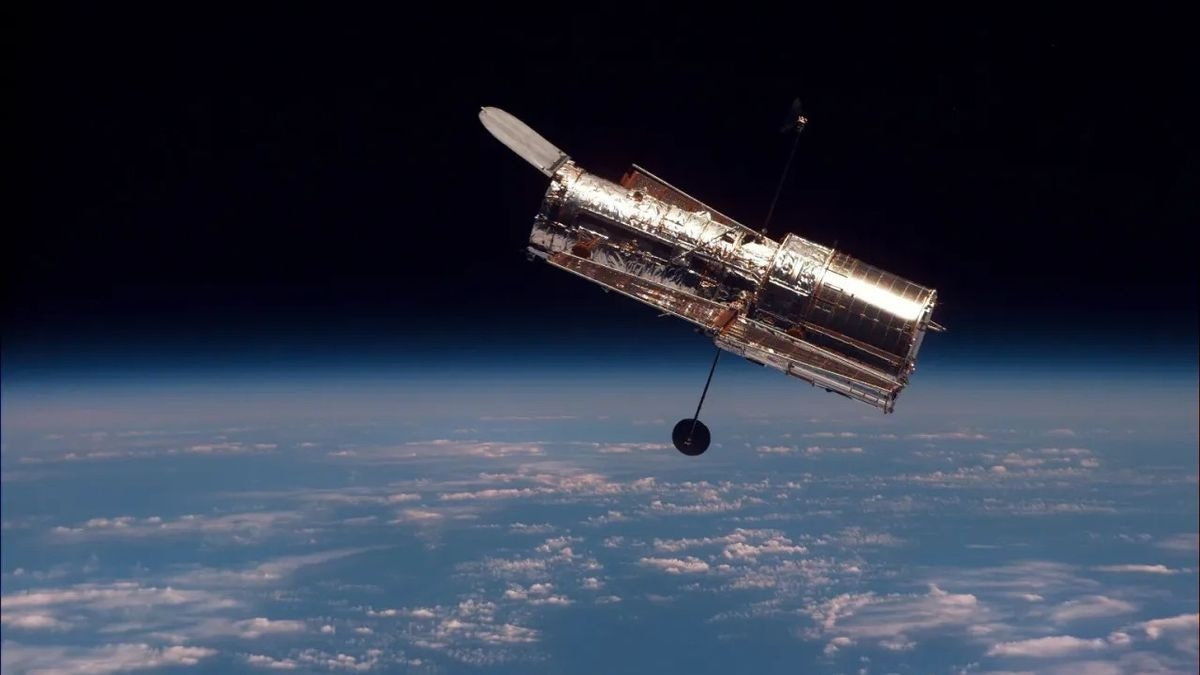
NASA's iconic Hubble observatory still has years of life left in it, and there are ideas in the works to perhaps keep it going for longer — but those proposals may be facing uphill battles.
The Hubble Space Telescope, launched in 1990, has been serviced five times by astronauts and remains in good health. But the telescope is aging and slowly falling toward Earth through natural drag from the atmosphere, so billionaire entrepreneur and private astronaut Jared Isaacman helped spearhead a proposal to send a maintenance mission to the telescope for the first time since 2009.
Isaacman — the commander of the private Inspiration4 mission in 2021, which he also financially backed — is also the funder and an astronaut of the Polaris Program. Polaris is a three-mission private astronaut series flying with SpaceXhardware that plans to run the first-ever commercial spacewalk as soon as this year, with Polaris Dawn.
The Polaris Program's Hubble proposal was first made public in 2022, and NASA asked other companies to send in ideas as well in a request for information (ROI) that closed in early 2023. There have been no official updates about the ROI yet, but the matter recently reappeared in the news with a report from National Public Radio. The broadcaster obtained internal NASA emails through a Freedom of Information Act request, showing a range of reactions that included concerns from some people about the risk to Hubble.
Hubble's last servicing mission in 2009 was a difficult decision for NASA. The agency, working in the wake of the Columbia space shuttle disaster of 2003 that killed seven astronauts, initially canceled the planned maintenance mission. Their concern was that the Atlantis space shuttle could not reach the International Space Station for assistance, if necessary, due to Hubble's orbit, far away from the orbiting complex.
After the scientific community expressed concern, however, NASA reinstated the mission with backup: another space shuttle, Endeavour, was put on the launch pad ready to help Atlantis if needed. The carefully choreographed maintenance mission didn't need the backup, however; it met its major servicing goals for Hubble, and the astronauts returned home without incident.
Hubble continues to perform observations, following decades of groundbreaking work in areas ranging from the expansion of the universe to exploring changes in planetary weather.
Hubble cannot continue like this forever, however: instruments and systems are growing older, the telescope periodically experiences "safe modes" (most recently for about a week in April), and the drag of Earth's atmosphere is slowly bringing it down from its orbit of approximately 320 miles (515 kilometers). (For comparison, the ISS is at roughly 250 miles, or 400 km.)
Moreover, the space shuttle and its ample payload bay for repairs is no longer available; that program retired in 2011, requiring new engineering solutions if anyone wanted to service Hubble again. The timeline for such a mission would likely require years of planning, and as there has been no update on the proposals since 2023, the status of any potential new servicing effort is unclear.
Hubble's instruments and primary subsystems (such as solar arrays and batteries) "will continue to operate through the latter part of the 2020s and possibly into the 2030s," assuming no unforeseen occurrences, NASA officials have stated. Isaacman and the Polaris Program, however, hope to keep Hubble going for much longer — perhaps an additional two decades — via a maintenance mission.
The lengthy NPR report highlighted several different stances from interviewees and from emails, ranging from praise for the innovation of Polaris and for the quality of the technical work, to concern about a few things. Among those concerns was that Polaris has not performed a spacewalk yet, that the SpaceX EVA [extravehicular activity] suits have not yet been tested in space, that reaching Hubble is difficult even for NASA astronauts and that any spacewalknear the telescope poses a risk of damage to it.
(Isaacman was unavailable for an NPR interview due to his Polaris training schedule, SpaceX did not respond to NPR's requests, and NASA sent brief statements to the broadcaster promising detailed follow-ups publicly in the near future. The European Space Agency, also a funder for the telescope, was not interviewed.)
The joint NASA-Polaris Hubble feasibility study has not yet been released, but "hopefully that comes out," Isaacman wrote on X (formerly Twitter) saying that a technical analysis was performed for six months and a formal recommendation was made.
Isaacman added that he fears the public discourse since then has been incorrectly, in his view, falling into camps including "new space vs. old space, or people who love SpaceX vs. hate SpaceX, incompetent tourist vs. real astronaut."
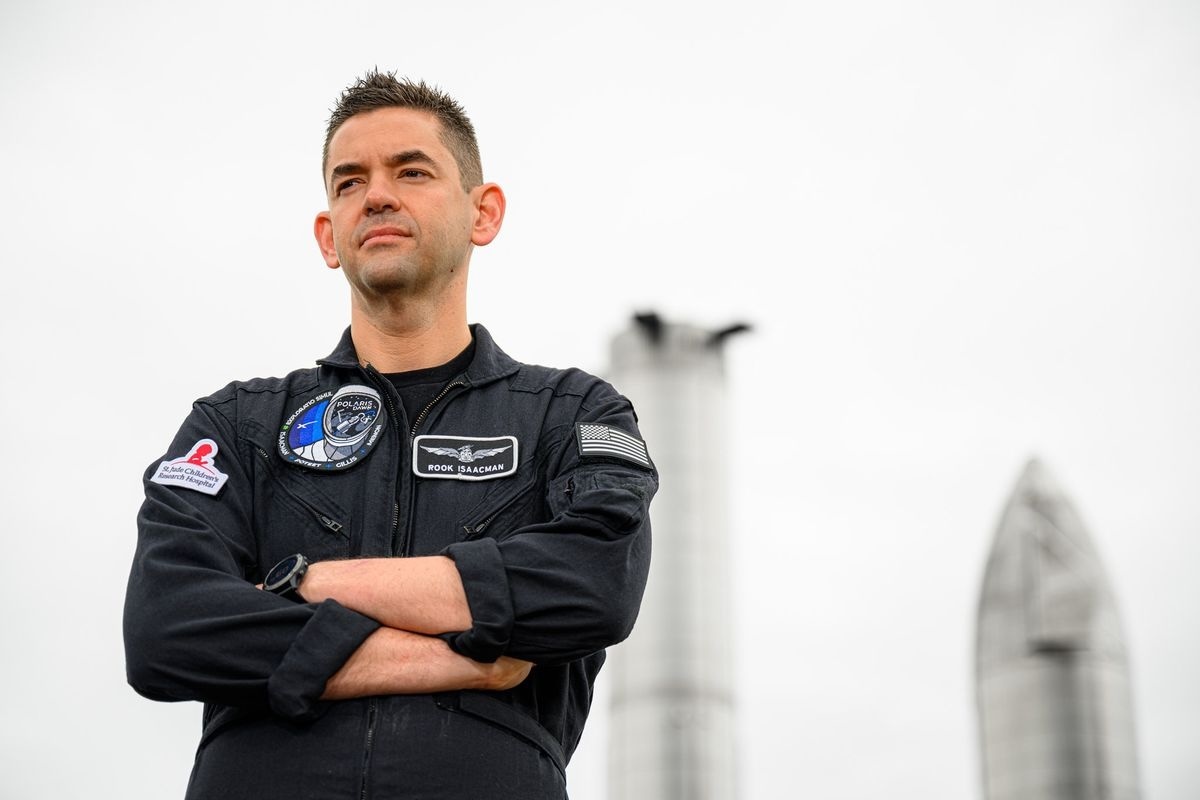
"It should really have only been about the mission, because if a mission was planned it would have had resources across all the organizations that participated in the study to ensure success," Isaacman emphasized.
"It is not like anyone was going to wing it, especially after a joint study was assembled to determine generally how a successful mission could be achieved," added Isaacman, whose resume includes more than 6,000 hours piloting various aircraft, including time dealing with contingencies or performing flight formations.
Isaacman paid tribute to the past servicing missions managed by NASA. Each required several rounds of spacewalks along with large instrument replacements and the use of the space shuttle's Canadian robotic arm, called Canadarm. Planning for these missions would always take several years, including ample spacewalking practice by agency astronauts.
Advances in electronics over the past 15 years, however, means "you can pack a lot of capabilities in to something the size of an iPhone these days," Isaacman said.
As for the risk to Hubble in servicing it again, Isaacman said that, aside from the fact that Hubble is falling back to Earth, "many of the telescope systems have failed and most redundancy has been lost. This is why it continues to go offline."
In a recent NASA statement, agency officials pointed to a single faulty gyroscope as the culprit behind the April 2024 safe mode incident, as well as another in November 2023. But there are still two other gyroscopes Hubble can use to orient itself in space.
While three of Hubble's six gyros are no longer in operation, and the best efficiencies come from using at least three for pointing, the observatory "could continue to make science observations with only one gyro if required," the statement said. As for Hubble's near-term health: "NASA anticipates Hubble will continue making groundbreaking discoveries," the statement emphasized.
Hubble, Isaacman said, could only be boosted by Polaris until it reaches a "certain altitude," at which point (according to Isaacman) it would either fall uncontrolled back to Earth or — if a rescue effort were desired at that point — would have to be addressed by a robotic mission, which may be at taxpayer expense depending on what NASA wants to do.
"Had a mission been flown, and I was happy to fund it, I believe it would have resulted in the development of capabilities beneficial to the future of commercial space and along the way given Hubble a new lease on life," Isaacman added.
"I acknowledge this is not my telescope to touch and a lot of time has passed from the study till now. Government priorities change, budgets become tight. Regardless of who is funding the mission, it does require contributions of resources from a lot of parties to ensure success. Regardless of what happens from here, I am glad we all, inclusive of NASA, invested the time to see if this could work. Hubble deserved that effort."
Quelle: SC
----
Update: 28.05.2024
.
NASA should let a commercial mission save Hubble
In this image released by the National Aeronautics and Space Administration (NASA), astronaut Richard M. Linnehan works to replace the starboard solar array on the Hubble Space Telescope (HST) during an extravehicular activity (EVA) to try and upgrade some components of the telescope March 4, 2002 in space. (Photo by NASA/Getty Images)
Jared Isaacman, the billionaire entrepreneur behind the recent Inspiration4 commercial space mission and the upcoming Polaris Dawn private space flight, would like to save the Hubble Space Telescope on his own dime. All he needs is for NASA to approve such a mission.
However, according to NPR, some managers at the space agency, far from being excited, expressed concerns in emails obtained by the news organization.
The Hubble Space Telescope was one of the first and still is one of the most celebrated space observatories that NASA has ever deployed. It was launched in April of 1990 by the space shuttle Discovery. The telescope was designed to be periodically serviced by the space shuttle, which turned out to be very fortunate because NASA soon discovered, much to its chagrin, that the mirror was flawed, greatly inhibiting its usefulness.
The space shuttle Endeavour visited Hubble in December 1993 and installed, among other things, a corrective lens package that restored the space telescope to its full capacity. NASA conducted four more servicing missions to Hubble, the last being aboard the space shuttle Atlantis in May 2009.
The scientific wonders that the Hubble Space Telescope has discovered are too numerous to mention. It has imaged everything from distant galaxies, nebulas and stars to objects within our solar system. But, if nothing is done, Hubble’s orbit will decay about the year 2034 or sooner and it will enter the Earth’s atmosphere. Its pieces will be scattered across land and sea, much as happened to Skylab in the late 1970s.
Since the space shuttle program was discontinued, the orbiters are no longer available to service the Hubble Space Telescope. That’s where Jared Isaacman’s proposal comes in.
Isaacman proposes that he and a crew of private astronauts take a SpaceX Crew Dragon to the Hubble Space Telescope. The Crew Dragon would be used to boost Hubble’s orbit to extend its life by several years. Also, the astronauts would perform a spacewalk to repair/enhance some of the components of the space telescope.
The sticking point seems to be NASA’s risk-averse safety culture.
A Hubble Space Telescope servicing mission when the space shuttle was still flying was a meticulous and difficult undertaking. NASA astronauts practiced such missions for months before undertaking them. The shuttle would approach Hubble and take control of it using the Canadian-built robot arm. The arm would berth the telescope in the shuttle’s cargo bay, where the astronauts could get to it easily. After the servicing mission was complete, the robot arm would release Hubble and the shuttle would return to Earth.
The Crew Dragon does not have a robot arm or even an airlock. Astronauts on the SpaceX spacecraft would have to vent the atmosphere from the crew cabin entirely before opening the hatch. They would have to work tethered to Hubble before returning to the Crew Dragon.
Emails obtained by NPR suggest that some NASA managers can foresee scenarios in which spacewalking astronauts are killed, people servicing Hubble accidentally break the space telescope, or both. Needless to say, the private sector’s risk tolerance is a little more relaxed than NASA’s
Isaacman intends to take a crew on board a Crew Dragon on the Polaris Dawn mission to practice spacewalks using new EVA suits designed by SpaceX. The experience gained by that mission should indicate the possibility for success that a private Hubble servicing mission could have.
No reason exists to prevent NASA and Isaacman from sitting down, airing the space agency’s concerns and developing a plan for a Hubble servicing mission. With the end of the space shuttle era, it is not as if the space agency has a lot of options if it wants to extend Hubble’s useful lifespan.
On the other hand, it is probably past time that NASA start thinking of a replacement for Hubble. Hubble, as magnificently as it has performed, is based on decades-old technology. A more modern space telescope that can see in the visual light range would be a boon for astronomy.
A recent piece in the Next Big Future proposes making a SpaceX Starship into a space telescope. The Starship can accommodate a mirror 9 meters in diameter, versus Hubble’s 2.4-meter mirror. The article suggests that the cost of building and deploying such a space telescope would be $250 million to $500 million.
The secrets that such a telescope might extract from the universe are beyond evaluation.
Quelle: The Hill
----
Update: 5.07.2024
.
SpaceX targeting July 31 for launch of historic Polaris Dawn astronaut mission
It will be the second spaceflight for billionaire Jared Isaacman.
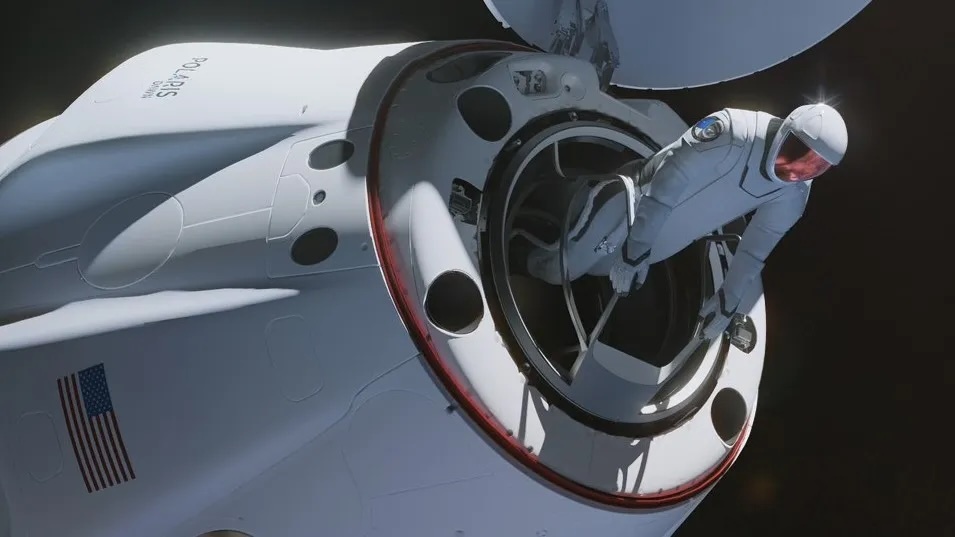
Illustration of a Polaris Dawn crewmember conducting the first-ever private spacewalk. (Image credit: SpaceX)
The first commercial spaceflight mission with a spacewalk now has a launch date.
Polaris Dawn, part of a private human spaceflight program funded by billionaire Jared Isaacman, will launch no earlier than July 31, project representatives announced today (July 3) in a brief statement on X. Isaacman and SpaceXfounder and CEO Elon Musk, whose company will provide Polaris Dawn's Dragon capsule and Falcon 9 rocket, have not yet put statements out on social media.
The crew plans to conduct the first-ever private spacewalk with bespoke SpaceX spacesuits made for the effort, along with a raft of experiments. Polaris Dawn's orbit will take the mission about 435 miles (700 kilometers) above Earth, in the highest-altitude crewed flight since the Apollo moon missions of the 1960s and 1970s. For comparison, the International Space Station orbits at roughly 250 miles (400 km).
Polaris Dawn will be the first of a trio of missions of the Polaris Program, all funded and commanded by Isaacman. The Shift4 founder also helmed and bankrolled the all-civilian Inspiration4 launch in September 2021, which raised $250 million for St. Jude Children's Research Hospital in Tennessee along the way; Isaacman plans to continue that support with the Polaris missions.
Aside from Isaacman, the mission includes retired United States Air Force (USAF) Lieut. Col. Scott "Kidd" Poteet as pilot and mission specialists Sarah Gillis and Anna Menon, both SpaceX operations engineers.
The complexity of the mission, according to project representatives, required delays during development from an initial launch target of late 2022. The most recent major delay in February 2024 pushed the projected April launch into summer.
"The additional time continues to provide necessary developmental time to ensure both the completion of these mission goals and a safe launch and return of Dragon and the crew," the Polaris Program said via X at the time.
The training schedule has been evolving as well, Poteet stressed in a "Spaces" discussion on X on May 4. "We've kind of piled on to what NASA has done over generations as far as identifying environments and situations that are stressful," he said, noting that part of the work has been learning about where teammates do well and where they may need help.
Quelle: SC

